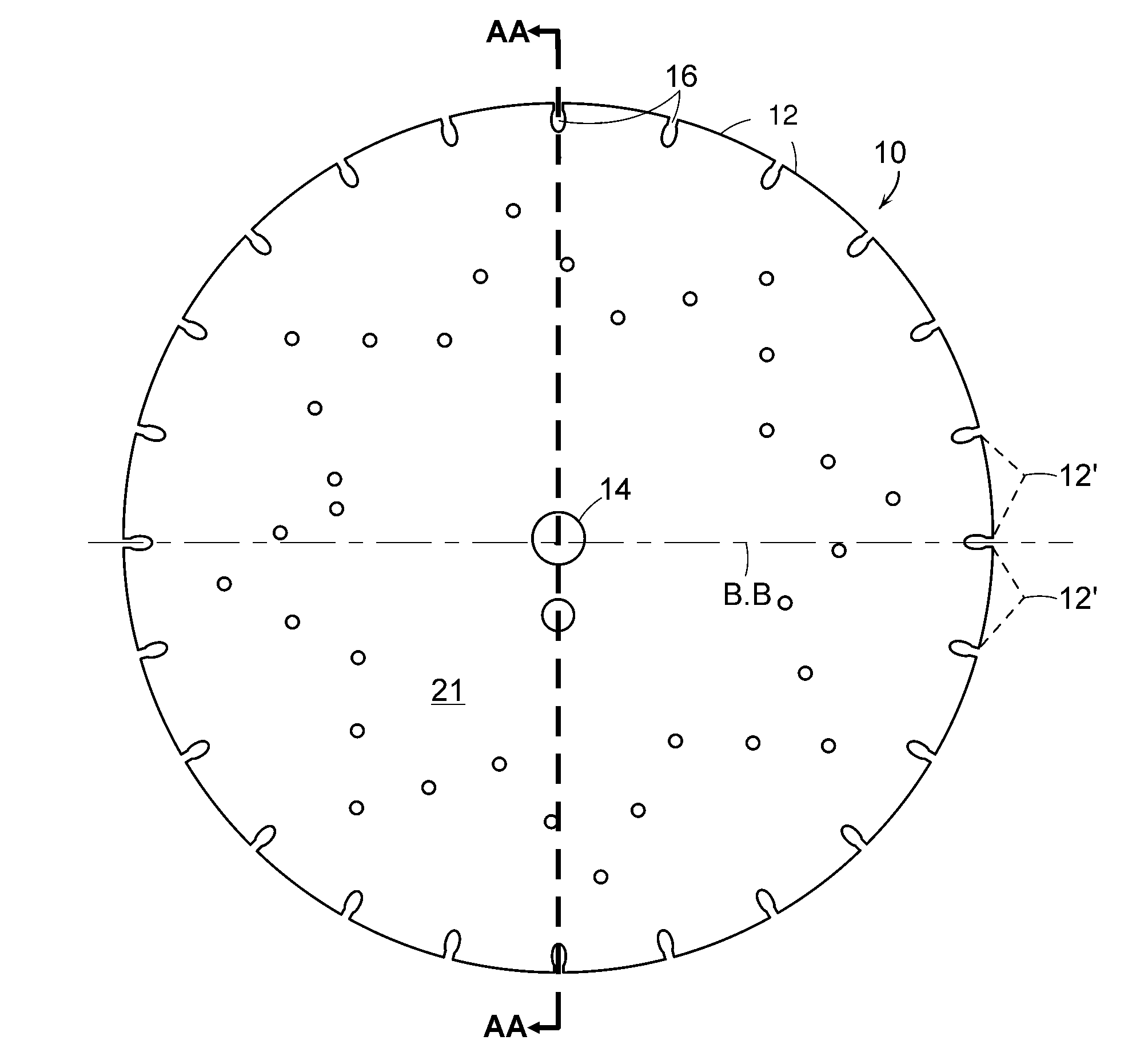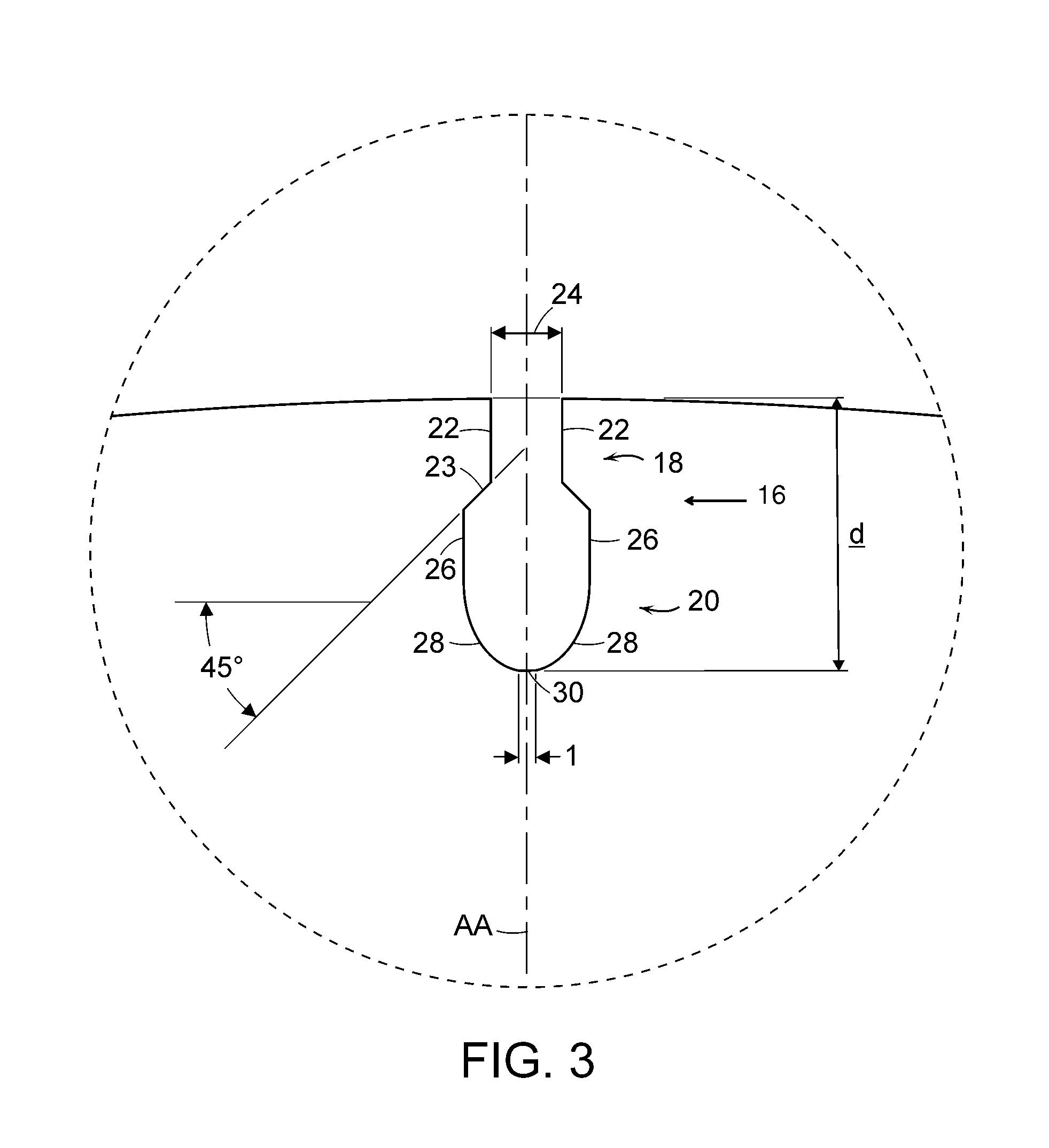Saw blade gullet configuration
a technology of gullet and saw blade, which is applied in the field of circular saw blades, can solve the problems of over-riding the fatigue barrier, cracks tend to propagate from the tightly radiused ends of these gullets, and the tight radius of the gullet is tightly radiused
- Summary
- Abstract
- Description
- Claims
- Application Information
AI Technical Summary
Benefits of technology
Problems solved by technology
Method used
Image
Examples
example 1
Control
[0032]Circular saw blades having conventional angled, circular base, keyhole gullets were tested to identify the effect of gullet orientation on crack formation. As shown in FIG. 5A, one saw blade was provided with angled keyhole gullets 116 having neck portions 118 extending at an acute angle α (70°) from the leading portion of the wheel periphery. Another saw blade was provided with similar keyhole gullets 216 having neck portions 218 extending at an obtuse angle β (110°) from the leading portion of the wheel periphery, as shown in FIG. 5B. Gullets 116 extended approximately 9 mm radially inward from the periphery, while gullets 216 extended about 15 mm radially inward. Both gullets included parallel side walls 122, 222, an opening 24 at the periphery of about 3 mm in width, and circular bases 120, 220 having diameters of 0.6 mm.
[0033]These saw blades were installed on a gasoline powered handheld saw (STIHL™ TS760, manufactured by Andreas Stihl AG, Waiblingen, Germany), and...
example 2
Control
[0034]A circular saw blade having conventional radially-extending keyhole gullets was also tested. As shown in FIG. 6, these gullets 316 were configured to be substantially similar to gullets 216, though with a neck 318 extending radially inward in a direction substantially orthogonal (i.e., at an angle θ of 90°) from the periphery. This saw blade was installed onto a floor saw (Clipper CSB1 P13, manufactured by Saint-Gobain S.A., Luxembourg) and tested by wet-cutting a concrete workpiece. As shown, gullet 316 developed a crack 332 extending radially inward from the radially innermost portion of base 320.
example 3
[0035]A circular saw blade (Blade 3) of the invention, having gullets 16 substantially as shown and described with respect to FIGS. 1-3 was tested and compared with two other saw blade types (Blades 1 and 2) respectively having short and long necked versions of gullets 316 (FIG. 6). The short necked gullets of Blade 1 were configured as described in Example 2, extending radially inward to a depth d of 9 mm. The long necked gullets of Blade 2 were nominally identical to those of Blade 1, though extending to a depth d of 15 mm. The gullets of Blade 3 extended to a radial depth d of 10 mm and had a gullet opening 24 of 3 mm. The 45° angled wall portions extended along a notional line that intersected axis AA 1.49 mm radially inward of the wheel periphery. Linear base portions 26 were disposed about 5.2 mm apart, and extended to a radial depth of about 6 mm before fairing into elliptically arced portions 28 which terminated at linear base portion 30 of 1 mm in length.
[0036]All three whe...
PUM
| Property | Measurement | Unit |
|---|---|---|
| diameters | aaaaa | aaaaa |
| width | aaaaa | aaaaa |
| angle | aaaaa | aaaaa |
Abstract
Description
Claims
Application Information
 Login to View More
Login to View More - R&D
- Intellectual Property
- Life Sciences
- Materials
- Tech Scout
- Unparalleled Data Quality
- Higher Quality Content
- 60% Fewer Hallucinations
Browse by: Latest US Patents, China's latest patents, Technical Efficacy Thesaurus, Application Domain, Technology Topic, Popular Technical Reports.
© 2025 PatSnap. All rights reserved.Legal|Privacy policy|Modern Slavery Act Transparency Statement|Sitemap|About US| Contact US: help@patsnap.com



